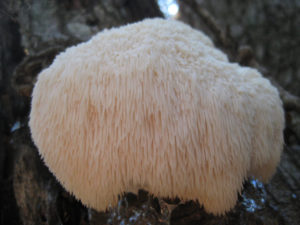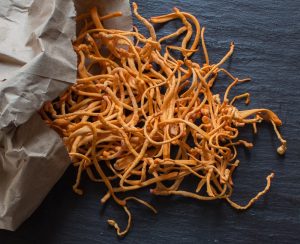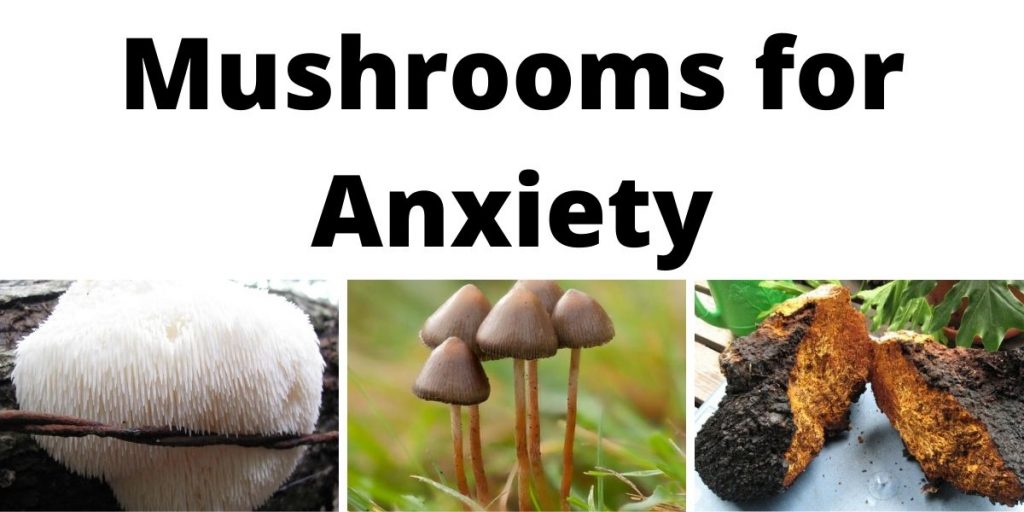Taking Medicinal Mushrooms for Anxiety is intriguing because from the twentieth century and onward, chronic anxiety – which is characterized by feelings of apprehension and excessive physiological arousal and nervousness – has emerged as an explicit and pervasive issue for many. In the words of Dr. Charles D. Spielberger of Vanderbilt University, “the importance of anxiety as a powerful influence in contemporary life is increasingly recognized, and manifestations of current concern with anxiety phenomena are ubiquitously represented in literature, the arts, science, and religion…” In the behavioral and medical sciences, clinical interest in anxiety reflects the burgeoning public concern. As a result of empirical and theoretical scientific research, we understand now that anxiety is a principal causative agent for many consequences and maladies, including insomnia, irritability, lack of concentration, fatigue, stomach upset, and other debilitating and disturbing psychosomatic issues.[1]
As a result, there has been a growing interest in the treatment of Generalized Anxiety Disorder (GAD), the most common of which being anxiolytic medications and/or antidepressants in conjunction with talk therapies. GAD can vary dramatically in severity depending on the patient, and consequently, certain medications work for some sufferers and not with others, and the assigned dosage of medication is dependent on the individual’s specific condition.[2] Many sufferers of GAD have demonstrated interest in using alternative therapeutic agents as addendums to their primary treatments, particularly in light of the fact that some GAD medications can be dependency and habit-forming.[3] Interestingly, in clinical research, various types of medicinal mushrooms have emerged as possessing anxiolytic and antidepressant properties. Indeed, mushrooms and fungi have come to greater prominence in news media as therapeutic agents as more and more individuals seek out relief for chronic anxiety and more clinical researchers dedicate their studies to aiding these efforts. Some of these mushrooms appear to yield long-term relief for both anxious and depressive symptoms, which are often co-morbid.[4] [5] A handful of these fungi – as well as clinical support for their use – are described in greater detail below.
Best Mushrooms for Anxiety
Lion’s Mane

The Lion’s Mane mushroom, otherwise known by its scientific nomenclature Hericium erinaceus, is an edible and medicinal fungus endemic to several parts of eastern Asia. It is also colloquially known as the “Hedgehog Mushroom” or alternatively, “The Bearded Tooth Fungus” because of the long spines that protrude from its fruiting body. Lion’s Mane is not commonly utilized in the United States, per se, but it is very widely consumed in East Asian countries for its plentiful nutritional and health benefits.[6] Its fungal mycelia are known for their anti-cancerous, anticarcinogenic, antidiabetic, antihypertensive, hepatoprotective, anti-inflammatory, hypoglycemic, and possible anti-aging properties.[7] Further, some clinical evidence indicates that Lion’s Mane may be effective in enhancing cognitive function, memory, and concentration.[8] A wide range of research activities in recent years has demonstrated interest in Lion’s Mane’s potential efficaciousness in treating neurological diseases and conditions. For the purposes of this article, it is worth noting that some clinical evidence indicates that Lion’s Mane may be effective in the treatment of chronic psychological illnesses such as depression and anxiety.[9]
For example, in a study published by the Journal of Medicinal Food, researchers evaluated the antidepressant and anxiolytic impacts of the Lion’s Mane mushroom in adult male mice. Male laboratory mice were given either 20 or 60 mg/kg of Hericium erinaceus per day (or saline in the control group) for a total of four weeks. Next, researchers conducted open field and tail suspension tests approximately thirty minutes after the last administration of Lion’s Mane extract, followed by the forced swim test after two days. Results indicated that Lion’s Mane extract may have anxiolytic and antidepressant-like effects. To elucidate the possible mechanisms behind these therapeutic effects, researchers explored the proliferative activity of hippocampal progenitor cells, as well as neuronal survival in the dentate gyrus, 5-bromo-2′-deoxyuridine (BrdU). They found that Lion’s Mane extract increased the number of PCNA- and Ki67-positive cells in the hippocampus. Additionally, BrdU- and BrdU/NeuN-positive cells were significantly increased in the dentate gyrus when compared with the saline control group. Essentially, the results indicated that Lion’s Mane supplementation can exert anxiolyic and antidepressant-like effects by enhancing hippocampal neurogenesis. However, more research is needed to validate these findings, including clinical studies involving human subjects.[10]
Reishi

Reishi, otherwise known by its scientific nomenclature Ganoderma lucidum or its Chinese title Lingzhī, is a sapotrophic fungus that decomposes organic matter via extracellular digestion. Thriving primarily in warm or temperate climates, Reishi can be found on stumps, logs, and decayed trees, particularly oaks. In Latin, lucidum means “shiny” or “brilliant,” which aptly describes the fungus’s fruiting body, which has a varnished appearance on its surface. Because of its sculpted finish, the mushroom has also been often represented in art – in paintings, carvings of deer’s antlers, furniture and carpet designs, women’s hair combs, balustrades, etc. – stretching back to the Yuan Dynasty in China (1280 – 1368 A.D.). Reishi is further known for its spiritual potency and is believed to be a symbol and harbinger of good health, good fortune, and longevity in many East Asian cultures.[11]
Reishi is a relatively common mushroom that can be found throughout Asia, Australia, South America, Southern Europe, and parts of the Southeastern United States. In East Asia particularly (especially Japan, China, and Korea), the mushroom has a long and storied history of medicinal use. The fungus is highly reputable for its anti-inflammatory, anticarcinogenic, immunomodulating, renoprotective, anti-hypercholesterolemic, anti-arthritic, anti-hypertensive, and hepatoprotective properties and is thus known as a potential “cancer cure” and has been touted as the “king of all mushrooms.”[12]
Recent research has indicated that Reishi may indeed be effective as an anxiolytic as well. In a study published by the International Journal of Medical Research & Health Sciences, researchers utilized the light/dark box and elevated plus maze test with laboratory mice to evaluate the anxiolytic activity of an ethanol extract of the fruiting bodies and spores of Reishi. The extract was given orally at a dose of 20 mg/kg, 75 mg/kg, and 130 mg/kg of body weight, respectively. Diazepam (1 mg/kg) was used as a standard anxiolytic pharmaceutical treatment for comparison. Results indicated that the mice administered with Reishi demonstrated a significant increase in the time spent in the light cubicle when compared with the control group. Further, in the elevated plus maze test, Reishi supplementation resulted in significant increase in the number of open arm entries in comparison to the control group. Overall evidence indicated that ethanol extract of Ganoderma lucidum has anxiolytic activity comparable to roughly 1 mg/kg of diazepam.[13]
Another article published by BMC Complementary Medicine and Therapies yielded similar results with a water-soluble extract from a culture medium of Ganoderma lucidum in rats. Reishi was administered an hour prior to the forced swim test, elevated plus-maze, contextual fear-conditioning, and head twitch tests. Treatment with Reishi exhibited antidepressant-like effects in the forced swimming test, reduced freezing behavior in the contextual fear-conditioning test, and decreased the number of induced head twitches. Ultimately, it was concluded that Ganoderma lucidum may have both antidepressant and anxiolytic potential.[14]
However, it appears that the efficacy of Reishi as an anxiolytic depends largely on the type of extract. For example, a study published by the International Journal of Medicinal Mushrooms evaluated the anticonvulsant, antidepressant, and anxiolytic effects of an aqueous extract from cultured mycelia of the Reishi mushroom. Specifically, anxiolytic and antidepressant effects were evaluated using the forced swim test and the elevated plus maze test in laboratory mice. In this test, no anxiolytic or sedative effects were reported in mice treated with the extract (400-600 mg/kg).[15]
Cordyceps

Cordyceps refers to a genus of about 400 species of pathogenic or parasitic mushrooms that grow from within various insects and arthropods and consume roughly 90% of their hosts’ bodies. The most commonly used and widely studied Cordyceps mushrooms include the species Cordyceps sinensis, or the “caterpillar fungus,” followed by the species Cordyceps militaris, which typically grows in the pupae of butterflies. Like many of the other mushrooms on this list, Cordyceps fungi have a long and storied history of medicinal utilization in several East Asian cultures. In particular, these mushrooms are known for treating conditions as diverse as night sweating, hyperglycemia, renal dysfunction and failure, heart disease, and liver disease. Further, these mushrooms may exhibit anti-tumor and immunomodulatory activity. Very recently, some clinical research has indicated that Cordyceps militaris in particular may possess anxiolytic properties as well.[16]
In a 2021 study published by Current Developments in Nutrition, researchers evaluated the antidepressant and anxiolytic effects of an extract formula of Cordyceps militaris and Poria cocos (or “China root,” another type of medicinal fungus) via the regulation of inflammation pathways in laboratory rats. Researchers used the sucrose preference test and the elevated plus maze test, and also measured levels of the neurotransmitters serotonin and dopamine in rats via High-Performance Liquid Chromatography (HPLC). Results indicated that the combination of Poria cocos and Cordyceps militaris significantly reduced glutamate in the amygdala and regulated the metabolism of serotonin and dopamine in the prefrontal cortex of the mice. Ultimately, it was concluded that Poria cocos and Cordyceps militaris complement each other and exhibit antidepressant and anxiolytic effects by modulating neurotransmitters and may thus be useful in the treatment depression and anxiety. However, this is the only study related to the Cordyceps militaris mushroom and anxiety to date, so more research is necessary to confirm these effects.[17]
Chaga

The Chaga mushroom, also known by its scientific nomenclature Inonotus obliquus, is a sapotrophic fungus that grows on birch, alder, beech, and oak trees and thrives in cold climates. It is somewhat difficult to identify for those unfamiliar with the mushroom due to its atypical fruiting body; the fungus has a parasitic growth pattern of spreading through decaying logs and trees and forming a mycelium-mass on the external bark that appears a bit like tar or black charcoal. Unlike many of the other mushrooms on this list, the Chaga mushroom is not necessarily typical in East Asian medicine, but it has been used medicinally in traditional Slavic medicine since the 11th century, roughly. Indigenous cultures such as the Ainu of the Sakhalin Islands and the Khanty of Northern Russia have also historically enjoyed the plentiful benefits of the mushroom. In clinical research, Chaga has been demonstrated as potentially efficacious against human hepatoma and colon cancer cell lines, as well as two strains of the human influenza virus (types A and B) and possibly Hepatitis C. It is also known for its immunomodulatory and anti-inflammatory therapeutic potential more generally.[18]
The Chaga mushroom is also considered to be an adaptogen, which refers to a type of herbal pharmaceutical beneficial for stress management as well as the correction of hormonal imbalances. As a result, many researchers and nutritionists have put forth the hypothesis that the Chaga mushroom and other similar adaptogens may play a role in managing anxiety and associated sleeping issues. Much research has been conducted to validate Chaga’s therapeutic potential, and studies have yielded that the fungus has anti-inflammatory, antioxidant, immunomodulatory, antibacterial, anti-hyperglycemic, and antiviral properties. Further, a study published by Food and Function indicated that Chaga may reduce both oxidative stress and cognitive dysfunction in amnesiac mice.[19] However, to date, there have not been any clinical studies specifically dedicated to the investigation of Chaga’s specific anxiolytic or antidepressant effects. Thus, more research is needed to validate the hypothesis that Chaga may be effective as an anti-anxiety therapy.
Psilocybin

Psilocybin (4-phosphoryloxy-N, N-dimethyltryptamine) is perhaps the most controversial on this list, as it refers to the major psychoactive alkaloid of some species of “magic mushrooms,” which are well-known hallucinogenics. Mushrooms that contain psilocybin can be found widely in Europe, South America, Mexico, and the United States, and can provide feelings of sensory distortion and euphoria comparable to psychedelic drugs such as Lysergic acid diethylamide, or LSD.
Despite the prevalence of its experimental use in the 1960s and 70s, only very few pharmacological data about Psilocybin were unveiled until relatively recently.[20] For example, landmark study was published in 2006 at Johns Hopkins Center for Psychedelic and Consciousness Research that explored the safety and potential positive therapeutic effects of microdosing Psilocybin. The study described a range of “acute perceptual changes, subjective experiences, and labile moods including anxiety.” At two months, the volunteers of the study described positive changes in their attitudes and behaviors consistent with changes described by community observers (it is important to note that Psilocybin was administered under supportive, physician-observed experiences in this case).[21] On the other hand, while Psilocybin is not considered addictive, it does have a high potential for abuse and may actually yield anxiety, hallucinations, and panic for some users.
With that being said, there is some clinical evidence to indicate that small to moderate doses of Psilocybin may have anxiolytic properties for some patients. For example, in a study published by the Journal of Psychopharmacology, twenty-nine patients with cancer-related anxiety and depression were randomly assigned and treated with 0.3 mg/kg of psilocybin or niacin in conjunction with psychotherapy. At the 6.5-month follow-up, Psilocybin was associated with improved attitudes towards death and significant reductions in depression or anxiety in approximately 60-80% of patients. The researchers concluded that single moderate-dose Psilocybin might produce anxiolytic and anti-depressant impacts in severely impacted patients.[22]
Another study published by ACS Pharmacology & Translational Science evaluated Psilocybin’s effects on individuals with attachment disorders, including attachment anxiety and attachment avoidance. Participants of this particular study were male long-term AIDS survivors with “moderate-severe demoralization (n-18).” After three months of Psilocybin-assisted psychotherapy, patients self-reported ratings of attachment anxiety decreased significantly from baseline. The Experiences in Close Relationships scale was also used by researchers to measure patients’ behavior. These findings indicate that Psilocybin-assisted psychotherapy may be a broadly applicable therapeutic modality in individuals with certain anxiety disorders.[23]
References:
[1] Spielberger C.D. (2013) Chapter One: Theory and Research on Anxiety. In C.D. Spielberger (Ed.), Anxiety and Behavior (pp. 3-19). Academic Press Books.
[2] Antony M.M. & K. Rowa (2008). Generalized anxiety disorder. In L. Craighead, W. E. Craighead & D. J. Miklowitz (Eds.), Psychopathology: History, Diagnosis, and Empirical Foundations (pp. 78–114). John Wiley & Sons Inc.
[3] Borkovec T.D. & A.M. Ruscio (2001) Psychotherapy for Generalized Anxiety Disorder. Journal of Clinical Psychiatry, 62(11): 37-42.
[4] Senthilingham M. (2020, January 28) One Dose of ‘Magic Mushroom’ Drug Reduces Anxiety and Depression in Cancer Patients, Study Says. CNN.
[5] Piore A. (2021, September 22) Magic Mushrooms May Be the Biggest Advance in Treating Depression Since Prozac. Newsweek Magazine.
[6] Ajungla T. & T. Wabang. (2016) Edible, Medicinal, and Red-Listed Monkey Head Mushroom Hericium erinaceus (Bull.) Pers. From Japfu Mountain of Kohima Needs Immediate Protection. Current Botany, 7: 33-35.
[7] Chen C.C., Chen W.P., Chen Y.P., Lee L.Y., Li I.C., Shiao Y., et al (2018) Neurohealth Properties of Hericium erinaceus Mycelia Enriched with Erinacines. Behavioural Neurology, 5802634.
[8] Azumi Y., Inatomi S., Mori K., Ouchi K., and Tuchida T. (2009) Improving Effects of the Mushroom Yamabushitake (Hericium erinaceus) on Mild Cognitive Impairment: A Double-Blind Placebo-Controlled Clinical Trial. Phytotherapy Research, 23(3): 367-372.
[9] Friedman M. (2015) Chemistry, Nutrition, and Health-Promoting Properties of Hericium erinaceus (Lion’s Mane) Mushroom Fruiting Bodies and Mycelia and Their Bioactive Compounds. Journal of Agricultural and Food Chemistry, 63(32): 7108-7123.
[10] Cho K.O., Hyoun G.K., Kim J.Y., Kim S.Y., & Ryu S. (2018) Hericium erinaceus Extract Reduces Anxiety and Depressive Behaviors by Promoting Hippocampal Neurogenesis in the Adult Mouse Brain. Journal of Medicinal Food, 21(2): 174-180.
[11] Wasser S.P. (2005) Reishi or Ling Zhi (Ganoderma Lucidum). In: M. Dekker (Ed.), Encyclopedia of Dietary Supplements (pp. 603-622). Routledge.
[12] Aslam M. & N. Khatian (2018) A Review of Ganoderma lucidum (Reishi): A Miraculous Medicinal Mushroom. Inventi Rapid: Ethnopharmacology, 4: 1-6.
[13] Ali A.S., Aslam M. & A. Nasir (2018) Anxiolytic-like Activity of an Ethanol Extract of Ganoderma lucidum in Mice. International Journal of Medical Research and Health Sciences, 5(6): 57-60.
[14] Iizuka H., Iwata N., Hibino Y., Kamiuchi S., Matsuzaki H., Shimizu Y., et al (2013) Antidepressant-like Effects of a Water-Soluble Extract from the Culture Medium of Ganoderma lucidum mycelia in rats. BMC Complementary Medicine and Therapies, 13(37): 2-8.
[15] Grzywnowicz K., Nieoczym D., Socala K., Stefaniuk D., & P. Wlaz (2015) Evaluation of Anticonvulsant, Antidepressant, and Anxiolytic-like Effects of an Aqueous Extract from Cultured Mycelia of the Lingzhi or Reishi Medicinal Mushroom Ganoderma Lucidum (Higher Basidiomycetes) in Mice. International Journal of Medicinal Mushrooms, 17(3): 209-218.
[16] Panda, A. K., & Swain, K. C. (2011) Traditional uses and medicinal potential of Cordyceps sinensis of Sikkim. Journal of Ayurveda and Integrative Medicine, 2(1): 9–13.
[17] Chang W.T., Chen M.H., Huang H.S., Kuan-Hung L., Lin Y.E., Lu Y-S., et al (2020) The Antidepressive and Anxiolytic Effects of formula Consisted of Poria cocos and Cordyceps mlitaris Waster Medium Extract in Unpredictable Chronic Mild Stress Animal Model. Current Developments in Nutrition, 4(2): 1212.
[18] Peng H. & F. Shahidi (2020) Bioactive Compounds and Bioactive Properties of Chaga (Inonotus obliquus) Mushroom: A Review. Journal of Food Bioactives, 12: 9-75.
[19] Giridharan V.V., Konishi T. & R.A. Thandavarayan (2011) Amelioration of Scopolamine Induced Cognitive Dysfunction and Oxidative Stress by Inonotus obliquus – A Medicinal Mushroom. Food & Function Journal, 2(6): 320-327.
[20] Emrich H.M., Schneider U., Seifert J. & T. Passie (2006) The Pharmacology of Psilocybin. Addiction Biology, 7(4): 357-364.
[21] Griffiths R.R., Jesse R., McCann U., & W.A. Richards (2006) Psilocybin can Occasion Mystical-Type Experiences Having Substantial and Sustained Personal Meaning and Spiritual Significance. Psychopharmacology, 187(3): 268-292.
[22] Agin-Liebes G., Babb J., Belser A., Bossis A., Cohen B., Corby P., et al. (2016) Rapid and Sustained Symptom Reduction Following Psilocybin Treatment for Anxiety and Depression in Patients with Life-Threatening Cancer: A Randomized Controlled Trial. Journal of Psychopharmacology, 30(12): 1165-1180.
[23] Anderson B.T., Ortigo K.M., Stauffer C.S. & J. Woolley (2021) Psilocybin-Assisted Group Therapy and Attachment: Observed Reduction in Attachment Anxiety and Influences of Attachment Insecurity on the Psilocybin Experience. ACS Pharmacology & Translational Science, 4(2): 526-532.



